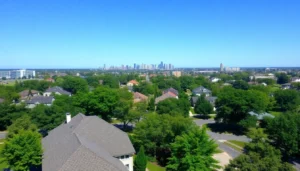In the grand circus of politics, the right and left often steal the show, each with their own flair and fanfare. Picture it: on one side, the right champions tradition and fiscal responsibility, while the left dances to the beat of social justice and progressive change. It’s a showdown that’s as lively as a family dinner where everyone has a different opinion on pineapple pizza.
But why should anyone care about this ideological tug-of-war? Because understanding the nuances of right vs left politics isn’t just for political junkies; it’s essential for anyone who wants to navigate today’s world. From social issues to economic policies, these opposing forces shape the landscape of our daily lives. So buckle up and get ready to dive into the colorful world of political ideologies, where every opinion counts and laughter is often the best medicine.
Table of Contents
ToggleOverview of Right vs Left Politics
Right and left politics represent two primary ideological spectrums in political discourse. Right-oriented groups typically emphasize tradition, individual liberties, and fiscal responsibility. They often advocate for free-market economics, smaller government, and limited regulation, prioritizing personal responsibility in society.
Left-oriented ideologies focus on social justice, equality, and progressive change. Prominent policies include universal healthcare, higher taxation on the wealthy, and increased government intervention in the economy to address systemic inequities. These perspectives aim to promote the welfare of marginalized communities and work towards creating a more equitable society.
Debates arise over key issues like healthcare, taxation, and civil rights. Right factions argue that tax cuts stimulate economic growth while left proponents suggest increased taxes fund social programs. Arguments often reflect fundamental values, with right supporters seeing a thriving private sector as essential, while left advocates view government intervention as necessary for fairness.
Understanding these polarities contributes to grasping broader political conversations. Familiarity with right and left ideologies cultivates critical thinking, enabling informed discussions about policies on climate change, education reform, and labor rights. Awareness of these viewpoints creates a framework for navigating political landscapes, influencing decisions at both local and national levels.
In essence, right and left politics embody contrasting yet essential perspectives, shaping laws and values within society. Engaging with these ideologies equips individuals to comprehend the complexities of contemporary issues, promoting participation in the political arena.
Historical Context

Understanding the historical context of right and left politics reveals how these ideologies evolved over time, influencing modern governance and policymaking.
The Evolution of Political Spectrum
The political spectrum emerged during the 18th century amidst the Enlightenment. Philosophers like John Locke and Jean-Jacques Rousseau shaped early concepts of governance. Initially, terms like “right” and “left” linked to seating arrangements in the French National Assembly. Right-wing members supported monarchy and tradition, while left-wing members advocated for revolutionary change and equality. Over the years, these concepts expanded globally, incorporating various social and economic issues. Economic influences differentiated the ideologies further, with the right typically favoring capitalism and the left leaning toward socialism. Contemporary movements continue to reflect these foundational ideas while adapting to current societal challenges.
Key Figures in Right and Left Politics
Influential figures shaped both right and left ideologies throughout history. On the right, notable individuals include Margaret Thatcher, who championed free-market policies in the UK during the 1980s. Her focus on privatization and deregulation set the stage for modern conservative movements. Conversely, on the left, Franklin D. Roosevelt introduced the New Deal, emphasizing government intervention to recover from the Great Depression. Social leaders like Martin Luther King Jr. highlighted civil rights, steering leftist ideology toward social justice. Each figure contributed to defining and refining political perspectives, impacting policy debates and public opinion across generations.
Key Ideological Differences
Right and left political ideologies embody distinct social and economic principles that shape policies and national debates.
Economic Perspectives
Right-oriented individuals typically advocate for free-market capitalism. They emphasize minimal government involvement in the economy, arguing that this approach fosters innovation and growth. Tax cuts are often promoted as a means to stimulate investment and economic expansion. In contrast, left-oriented individuals endorse progressive taxation to redistribute wealth. They argue that higher taxes on the wealthy fund essential social programs, such as healthcare and education. Government intervention is viewed as necessary to address economic disparities and protect vulnerable populations. The rationale behind these approaches underscores a fundamental disagreement about the role of government in the economy and the best methods to achieve a thriving society.
Social Values
Individuals on the right often prioritize traditional values and personal responsibility. They stress the importance of family structures and community cohesion, advocating for policies that reflect these beliefs. Additionally, they may resist rapid social change, preferring to uphold established norms. On the left, values focus on social justice and equality. Advocates argue for comprehensive civil rights protections, environmental sustainability, and inclusivity across gender and sexual identities. This perspective promotes progressive change as essential for addressing systemic inequities. The prioritization of these differing values fuels ongoing debates over issues like education reform, climate responsibility, and healthcare access.
Major Political Parties and Movements
Understanding political parties forms a crucial part of navigating right and left ideologies. Each distinct movement plays a significant role in shaping political landscapes.
Right-Wing Parties
Right-wing parties prioritize tradition and economic liberalism. In the United States, the Republican Party exemplifies this ideology, advocating for lower taxes and minimal government intervention. Fiscal responsibility stands at the heart of their platform, influencing policies that favor businesses. Moreover, conservative parties in Europe, such as the Conservative Party in the UK, emphasize nationalism, limited government, and free-market principles. Advocacy for reduced regulations resonates within these groups, aiming to drive economic growth. Globally, parties like the BJP in India showcase the blend of cultural conservatism and economic liberalism, focusing on national identity alongside market-driven growth.
Left-Wing Parties
Left-wing parties emphasize social equity and government intervention. The Democratic Party in the United States represents progressive values, supporting healthcare reforms and increased taxation on the wealthy. Similar ideologies emerge among European parties, such as the Labour Party in the UK, which champions workers’ rights and social justice. Progressive taxation serves as a common theme, with left-oriented movements advocating wealth redistribution to address economic disparities. Various global leftist parties, including Podemos in Spain, focus on anti-austerity measures and policies aimed at tackling inequality. Collectively, these parties strive for inclusivity and systemic change, addressing historical injustices through legislative means.
Current Trends and Issues
Current trends in right versus left politics highlight the complexities and realities of the global political landscape. Key issues continue to ignite debates, shaping public opinion and policy decisions.
Global Perspectives
Various countries reflect the ideological divides between right and left politics. In Europe, right-wing populism has gained traction, driven by concerns over immigration and national identity. Conversely, left-leaning parties push for progressive reforms addressing inequality and climate change. In Latin America, socialist movements emerge as a response to economic instability, while right-wing governments advocate for free-market policies. Asian political landscapes display similar divides, with right-oriented parties often promoting nationalism, while left factions prioritize social justice. Understanding these global perspectives enhances comprehension of political dynamics worldwide.
Impact of Social Media
Social media plays a pivotal role in shaping political discourse. The platforms amplify voices from both the right and left, fostering polarized discussions. Left-leaning groups often utilize social media to advocate for social causes, while right-wing entities use these channels to mobilize support around traditional values. Misinformation spreads rapidly online, impacting public perceptions of important issues. Algorithms tend to create echo chambers, reinforcing ideological beliefs without exposing users to opposing viewpoints. Engagement with social media becomes essential for grasping current trends, as it influences political engagement and voter mobilization.
Understanding the nuances of right and left politics is essential for navigating today’s complex landscape. Each ideology offers unique perspectives on issues that shape society. Engaging with these differing viewpoints fosters informed discussions and critical thinking.
As political dynamics continue to evolve, recognizing the historical context and current trends helps individuals make sense of the ongoing debates. By staying informed about both sides, people can better participate in conversations that impact their communities and the world at large. Embracing this knowledge empowers everyone to contribute meaningfully to the political discourse.





